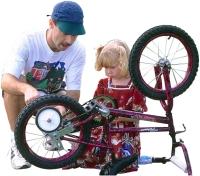 January 4th, 2012 by Robert Franklin, Esq.
January 4th, 2012 by Robert Franklin, Esq.
The number of stay-at-home dads is still a fraction of that of stay-at-home moms, but attitudes about fathers are changing for the better. The Census Bureau reports that there are about 176,000 SAHDs in the United States versus over 5 million SAHMs. In fact, the numbers for both are certainly higher. That’s because the Census Bureau defines “stay-at-home parent” as one who’s done no paid work in the past 12 months and had parenting as his/her major activity during the same time. That means if a parent works one day in the year and earns money for doing so, he/she is not a stay-at-home parent.
But the number of stay-at-home dads has gone pretty consistently up for the last 10 years. In 2000 there were about 93,000 and almost twice that number today. Still, compared to the number of stay-at-home mothers, 176,000 dads isn’t much. The overwhelming tendency of Americans is for the man to be the chief breadwinner and for the woman to “supplement” his earnings and to most of the childcare.
But the future may be different. The radical shift in the ratio of women to men in higher education is one reason. With about 58% of college degrees going to women, they’ll have the opportunity to be the higher earner in the couple once they marry. That would mean the possibility of a marked shift in roles at least among the college-educated. Typically, it’s the lower earner who ends up staying with the kids, for what should be obvious reasons.
Of course it’s also typical that Mom stays home with the kids. So what’s going to happen when Mom earns more Dad does? Study after study shows that, even among the best educated – those with law degrees, MBAs and PhDs in science, technology, engineering and math fields – women still take significant periods of time off work once children come along.
Will that change in the near future? A study by the Families and Work Institute found significant shifts in the attitudes of college-age young adults regarding the “work/life balance.” That would seem to be a harbinger of change in who earns and who cares for children, but I’m not so sure. The attitudes of young adults without children may well change when faced with the reality of earning and childcare. The reality of large percentages of mothers foregoing childcare in favor of the rat race is one I’ll believe when I see it.
Still, societal pressures for change continue to mount. More and more, fathers are being seen in a positive light that simply didn’t exist 10 years ago. Courts are now grappling with issues of parenting time that were foregone conclusions just a short time ago. Many state statutes now seek to remove discretion from family court judges in favor of specified considerations regarding the fitness of each parent. They tend to level the playing field for dads. Popular culture is no longer the swamp of anti-father propaganda it was in the 80s and 90s.
In that vein, comes this modest piece that’s essentially a paean to stay-at-home dads (USAToday, 12/29/11). It’s not long on data; in fact it’s just a feel-good piece about fathers, their benefits to children, children’s benefits to them and how the whole SAHD thing can work if couples will just let it But some couples simply have found that having dad at home with the children works for other reasons.
David and Amanda Dornfeld of Columbus decided before they were married that when they had children, David would stay at home when Amanda went back to work as a family practice physician.
“We are fortunate that we can do this,” Amanda said.
David has been the primary caregiver for the couple’s three children since the birth of their oldest, 6-year-old Luke. His days also include caring for Noah, 3, and Violet, 15 months.
“I love it a lot, but it’s exhausting,” said David, a certified public accountant. He squeezes in some work hours during the busy tax season.
David, 36, takes care of most of the typical household tasks, including grocery shopping, menu planning and cooking. Amanda does the laundry.
Amanda, 34, said she admires her husband’s parenting skills, from coordinating daily schedules and playing with the kids to remaining calm when sibling squabbles erupt.
“I always say his job is harder than mine. And he’s really, really good at it,” said Amanda, who works at Sandcrest Family Medicine.
It continues in the same tone through several couples, each with a stay-at-home dad, his supportive wife and their kids. As I say, there’s not a lot of depth, but in a way that’s my point. The article is an example of the type of “You go Dad!” piece that’s become commonplace in the past few years.
None of this changes the many obstacles in the way of the vast majority of fathers. Despite some new legislation, family courts haven’t much changed their bad old habits of ordering custody. Bogus claims of domestic violence still stand between countless fathers and children. Feminist organizatoins that should know better still invariably oppose the slightest improvement in father-child relationships. Child support practices continue to abuse parents, particularly fathers. Adoption law and paternity fraud law are open invitations to mothers to separate fathers from their children.
But, as we begin a new year, we can see the glacier moving. Changing laws, practices and public perceptions about fathers, mothers and their rightful relationships to work and children is one of the most difficult and daunting tasks imaginable. Those roles have been established for a long time and they don’t change easily. Still, things are changing, and for the better for fathers and children.
